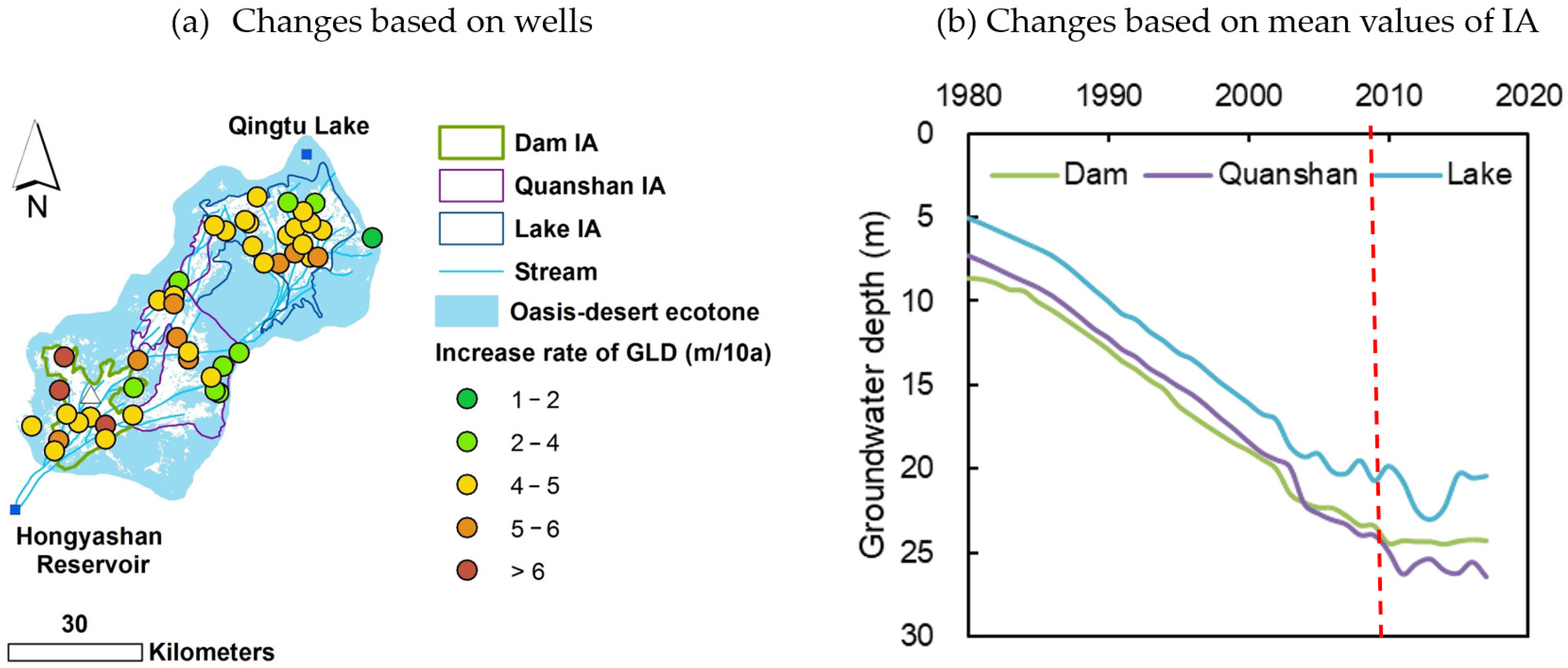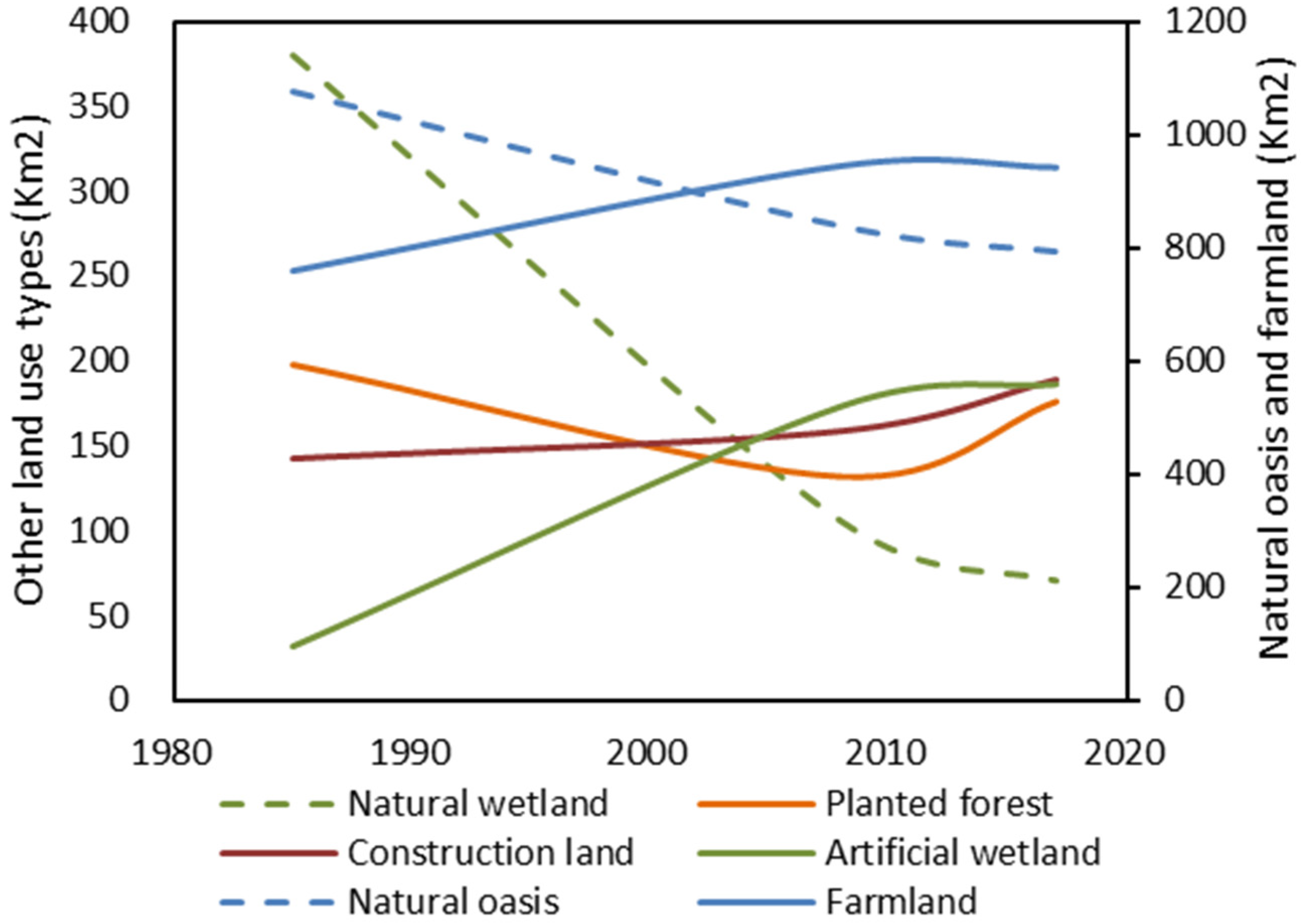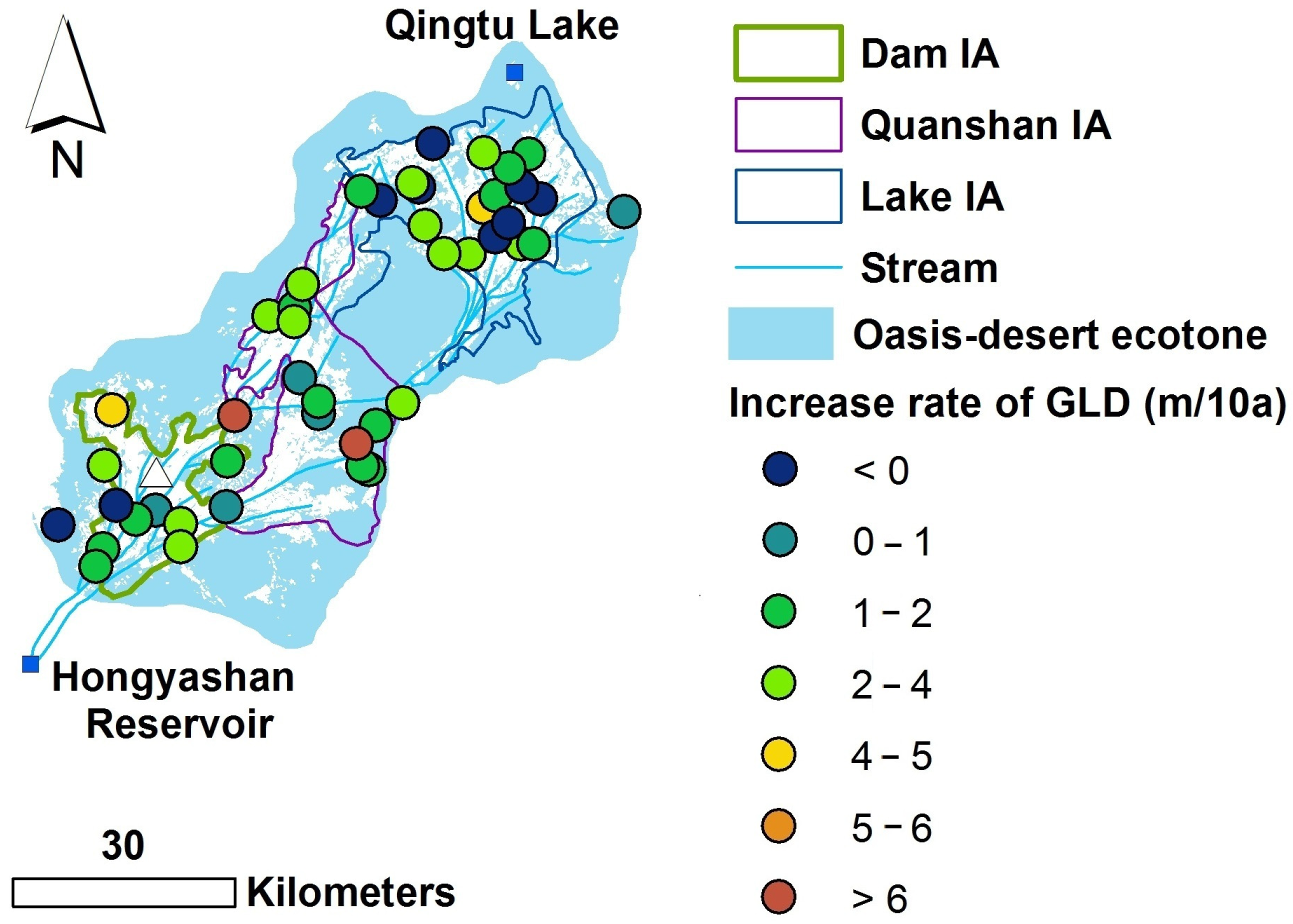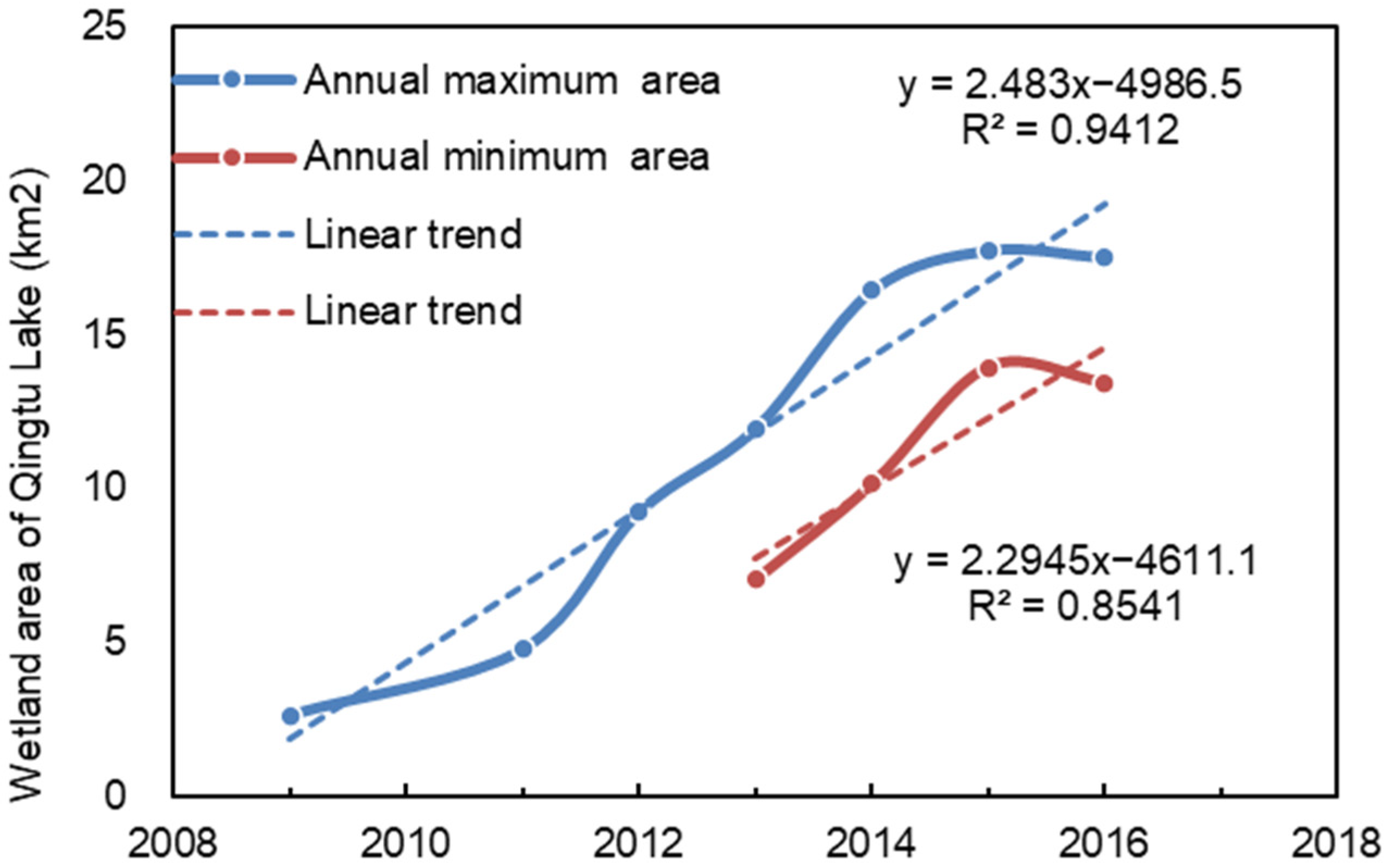Nature-Based Solutions for the Restoration of Groundwater Level and Groundwater-Dependent Ecosystems in a Typical Inland Region in China
Abstract
:1. Introduction
2. Materials and Methods
2.1. Study Area
2.2. Data
2.3. Methods
2.3.1. Mathematical Statistics Method
- Linear trend analysis
- 2.
- Correlation analysis
2.3.2. GLD—Natural Vegetation Quadrat Joint Survey
2.3.3. Fuzzy Comprehensive Evaluation Method
3. Results
3.1. Changes in Elements of Climate, Water Resources, and Ecology
3.1.1. Variations in Natural Hydro-Climatic Elements
3.1.2. Changes in Groundwater Depth
3.1.3. Changes in Land Use and Land Cover (LULC)
3.1.4. Changes in NDVI in Oasis–Desert Ecotone
3.2. Interactions among the Elements of Social and Ecological Systems
3.2.1. Farmland–Groundwater Abstraction–Groundwater Depth–Natural Oasis
3.2.2. The Relationship of Groundwater to the Main Vegetation Indicators
4. Discussion
4.1. The Effects of the Nature-Based Solutions
- The proportions of surface water and groundwater to total water supply amounts
- 2.
- Groundwater level recovery
- 3.
- Wetland area of Qingtu Lake
- 4.
- Vegetation ecology in the oasis–desert ecotone
- 5.
- Lifting residents out of poverty
4.2. Comprehensive Evaluation of the Resilience of the Socio-Ecological System
- Selection of the resilience indicators of the SES
- 2.
- Determination of grading values and the corresponding rating score
- 3.
- Determination of the weight for each resilience indicator
- 4.
- Composite evaluation index of the resilience of SES
4.3. Recommendations and Measures
- (1)
- The ODE is a natural vegetation protection region. The critical GLD of soil salinization (2 m) and the critical vegetation-degradation value of groundwater ecological function (5 m) are recommended as GLD thresholds [17,34]. In the near future (i.e., by the year 2035), the main goal is to restore the ecological functioning of groundwater and prohibit its overexploitation. In the long term (after 2035), attention should be paid to controlling the GLD less than 2 m to avoid salt desertification. Artificial afforestation should be suited to local conditions, and shrub and grass planting projects should conform to the local climate and environment, selecting drought- and salt-tolerant plant species.
- (2)
- In agroecosystem regions, groundwater should be extracted rationally. Multiple factors such as the amount of groundwater recharge, the soil salinization threshold of the GLD, and the influence of groundwater mining on the surrounding natural ecology should be comprehensively considered. The GLD values of 2 m and 10 m are recommended as the minimum and maximum thresholds, and the amount of groundwater extraction could be determined according to these GLD thresholds. Therefore, the near future goal of the agroecosystem region is food security. The local government should reasonably determine the scale of agricultural land and irrigate the farmland by the joint regulation of surface water and groundwater. In the long term, attention should be paid to controlling the GLD greater than 2 m to avoid causing secondary salinization of the soil and affecting the quality and yield of crop.
- (3)
- In the urban ecological security guarantee region, the safety guarantee of underground buildings is the primary task. The local government should reasonably determine the maximum GLD threshold and appropriately extract groundwater by holistically coordinating regional water level changes. The authors recommend the minimum and maximum thresholds as 10 m and 15–20 m, respectively, due to the conclusion that a high GL would lead to the instability of underground buildings.
5. Conclusions
- (1)
- The natural runoff flowing into Minqin Oasis decreased significantly at a rate of 81 million cubic meters per decade. Combined with the expansion of irrigated farmland in Minqin Oasis, GLD increased dramatically, and the natural vegetation ecology of the ODE was seriously degraded. There was a strong correlation between each couple factor among the four factors on the causal chain; i.e., expansion of farmland–increase in groundwater abstraction amount–increase in GLD–degradation of natural ecosystem.
- (2)
- Since the implementation of the NbS in 2007, the dropping trend of GL has been curbed, the natural vegetation of the ODE has been partially restored, the wetland area of Qingtu Lake has increased, and people’s income has also increased. The SES resilience index has increased by a factor of 1.82 from 2009 to 2017, but it was still below 0.6, and the GLD has not reached the ecologically suitable depth.
- (3)
- To continually improve the resilience of the SES of Minqin Oasis, the idea of harmonious coexistence between humans and nature should continue to be adhered to in the later comprehensive treatment of the SRB, and the implementation of the CASRB should focus on comprehensive management, systematic management, and zoning management to promote the integrated protection and restoration of mountains, rivers, forests, fields, lakes, grass, and sand.
Author Contributions
Funding
Data Availability Statement
Acknowledgments
Conflicts of Interest
References
- Intergovernmental Panel on Climate Change. Global Warming of 1.5 °C; Cambridge University Press: Cambridge, UK; New York, NY, USA, 2018. [Google Scholar]
- World Bank. Biodiversity, Climate Change, and Adaptation: Nature-Based Solutions from the World Bank Portfolio; World Bank: Washington, DC, USA, 2008. [Google Scholar]
- Cohen-Shacham, E.; Walters, G.; Maginnis, S.; Janzen, C. Nature-Based Solutions to Address Global Societal Challenges; IUCN: Gland, Switzerland, 2016. [Google Scholar]
- Cohen-Shacham, E.; Andrade, A.; Dalton, J.; Dudley, N.; Jones, M.; Kumar, C.; Maginnis, S.; Maynard, S.; Nelson, C.; Renaud, F.; et al. Core principles for successfully implementing and upscaling Nature-based Solutions. Environ. Sci. Policy 2019, 98, 20–29. [Google Scholar] [CrossRef]
- United Nations Development Programme. Human Development and Planetary Health: The Role of Nature-Based Solutions; United Nations: San Francisco, CA, USA, 2019; Available online: https://hdr.undp.org/content/human-development-and-planetary-healththe-role-nature-based-solutions (accessed on 16 September 2023).
- International Union for Conservation of Nature. Guidance for Using the IUCN Global Standard for Nature-Based Solutions: A User-friendly Framework for the Verification, Design and Scaling up of Nature-Based Solutions, 1st ed.; International Union for Conservation of Nature: Gland, Switzerland, 2020. [Google Scholar]
- European Environment Agency; Castellari, S.; Zandersen, M.; Davis, M.; Veerkamp, C.; Förster, J.; Marttunen, M.; Mysiak, J.; Vandewalle, M.; Medri, S.; et al. Nature-Based Solutions in Europe Policy, Knowledge and Practice For Climate Change Adaptation and Disaster Risk Reduction; Publications Office of the European Union, LU: Luxembourg, 2021. [Google Scholar]
- Pérez-Cirera, V.; Cornelius, S.; Zapata, J. Powering Nature: Creating the Conditions to Enable Nature-Based Solutions; WWF: Gland, Switzerland, 2021; Available online: https://lp.panda.org/powering-nature-report (accessed on 16 September 2023).
- European Union. Towards an EU Research and Innovation Policy Agenda for Nature-based Solutions & Renaturing Cities. 2015. Available online: https://publications.europa.eu/en/publication-detail/-/publication/fb117980-d5aa-46df-8edc-af367cddc202 (accessed on 16 September 2023).
- International Union for Conservation of Nature. Call for Wetland Decade under the UN Decade on Ecosystem Restoration (2021–2030). 2019. Available online: https://www.iucn.org/news/water/201903/call-wetland-decade-under-un-decade-ecosystem-restoration-2021–2030 (accessed on 16 September 2023).
- United Nations. Nature-based Solutions for Supporting Sustainable Development, Resolution 5 of United Nations Environment Assembly Adopted on 2 March 2022, 2022 Retrieved on 5 June 2022. Available online: https://wedocs.unep.org/bitstream/handle/20.500.11822/39864/NATURE-BASED%20SOLUTIONS%20FOR%20SUPPORTING%20SUSTAINABLE%20DEVELOPMENT.%20English.pdf?sequence=1&isAllowed=y (accessed on 16 September 2023).
- Mehta, D.; Pandey, R.; Gupta, A.K.; Juhola, S. Nature-based Solutions in Hindu Kush Himalayas: IUCN Global Standard Based Synthesis. Ecol. Indic. 2023, 154, 110875. [Google Scholar] [CrossRef]
- Yu, R.; Mu, Q. Implementation progress of NbS in China: A Global Comparative Review. NbS 2023, 4, 100075. [Google Scholar]
- Fan, X. The Characteristics of Groundwater Resources and the Environmental Problems Caused by Development of Water Resource, the Arid Area in the Northwest of China. Hydrol. Eng. Geol. 1990, 1, 3–7, 12–16. (In Chinese) [Google Scholar]
- Ding, H.; Wang, G.; Huang, X. Runoff Reduction into Hongyashan Reservoir and Analysis on Water Resources Crisis of Minqin Oasis. J. Des. Res. 2003, 23, 84–89. [Google Scholar]
- Cao, L.; Nie, Z.; Liu, M.; Wang, L.; Wang, J.; Wang, Q. Changes in Natural Vegetation Growth and Groundwater Depth and Their Relationship in the Minqin Oasis in the Shiyang River Basin. Hydro. Eng. Geol. 2020, 47, 25–33. (In Chinese) [Google Scholar]
- Liu, M.; Nie, Z.; Cao, L.; Wang, L.; Lu, H.; Wang, Z.; Zhu, P. Comprehensive Evaluation on the Ecological Function of Groundwater in the Shiyang River Watershed. J. Ground. Sci. Eng. 2021, 9, 326–340. [Google Scholar] [CrossRef]
- Hao, Y.; Xie, Y.; Ma, J.; Zhang, W. The Critical Role of Local Policy Effects in Arid Watershed Groundwater Resources Sustainability: A Case Study in the Minqin Oasis, China. Sci. Total Environ. 2017, 601–602, 1084–1096. [Google Scholar] [CrossRef]
- Huang, F.; Chunyu, X.; Zhang, D.; Chen, X.; Ochoa, C.G. A Framework to Assess the Impact of Ecological Water Conveyance on Groundwater-Dependent Terrestrial Ecosystems in Arid Inland River Basins. Sci. Total Environ. 2020, 709, 136155. [Google Scholar] [CrossRef]
- Zhang, Z.; Yang, X.; Li, H.; Li, W.; Yan, H.; Shi, F. Application of A Novel Hybrid Method for Spatiotemporal Data Imputation: A Case Study of the Minqin County Groundwater Level. J. Hydrol. 2017, 553, 384–397. [Google Scholar] [CrossRef]
- Wang, X.; Chen, X.; Ding, Q.; Zhao, X.; Wang, X.; Ma, Z.; Lian, J. Vegetation and Soil Environmental Factor Characteristics, and Their Relationship at Different Desertification Stages: A Case Study in the Minqin Desert-Oasis Ecotone. Acta Ecolo Sinica 2018, 38, 1569–1580, (In Chinese with English abstract). [Google Scholar]
- Zhang, Y.; Chang, Z. Study on the Dynamic Vegetation Degeneration in the Minqin Desert Area. Arid Zone Res. 2008, 25, 16–21, (In Chinese with English abstract). [Google Scholar] [CrossRef]
- Liu, H.; Liu, S.; Li, Y.; Yang, Z.; Li, Y.; Zhang, Y.; Guo, C.; Liu, S. Response of Riparian Vegetation to the Change of Groundwater Level at Middle and Lower Reaches of the Shiyang River. Arid Zone Res. 2012, 29, 335–341, (In Chinese with English abstract). [Google Scholar]
- Lu, H.; Nie, Z.; Liu, M.; Feng, B.; Cheng, X.; Wang, J.; Wang, Q.; Cui, H.; Fan, F. Research on Land Cover Changes in Shiyang River Basin in Recent 50 Years Based on RS and GIS. Geogr. Res. 2020, 29, 8, (In Chinese with English abstract). [Google Scholar]
- Hess, A.; Iyer, H.; Malm, W. Linear Trend Analysis: A Comparison of Methods. Atmos. Environ. 2001, 35, 5211–5222. [Google Scholar] [CrossRef]
- Xu, J. Mathematical Methods in Modern Geography, 2nd ed.; Higher Education Press: Beijing, China, 2002; pp. 305–335. [Google Scholar]
- Cohen, P.; Cohen, P.; West, S.G.; Aiken, L.S. Applied Multiple Regression/Correlation Analysis for the Behavioral Sciences, 2nd ed.; Psychology Press: London, UK, 1983. [Google Scholar] [CrossRef]
- Fang, J.; Wang, X.; Shen, Z.; Tang, Z.; He, J.; Yu, D.; Jiang, Y. Methods and Protocols for Plant Community Inventory. Biodi. Sci. 2009, 17, 533–548. (In Chinese) [Google Scholar]
- Lou, S. Fuzzy Mathematics; Science Press: Beijing, China, 1983. [Google Scholar]
- Song, S.; Nie, Z.; Geng, X.; Shen, X.; Wang, Z.; Zhu, P. Response of Runoff to Climate Change in the Area of Runoff Yield in Upstream Shiyang River Basin, Northwest China: A Case Study of the Xiying River. J. Groundw. Sci. Eng. 2023, 11, 89–96. [Google Scholar] [CrossRef]
- Jin, X. Quantitative Relationship Between the Desert Vegetation and Groundwater Depth in Ejina Oasis, the Heihe River Basin. Earth Sci. Front. 2010, 17, 181–186, (In Chinese with English abstract). [Google Scholar]
- Cao, L.; Nie, Z.; Liu, M.; Wang, L.; Wang, Q. The Ecological Relationship of Groundwater–Soil–Vegetation in the Oasis–Desert Transition Zone of the Shiyang River Basin. Water 2021, 13, 1642. [Google Scholar] [CrossRef]
- Chen, L.; Feng, Q. Geostatistical Analysis of Temporal and Spatial Variations in Groundwater Levels and Quality in the Minqin Oasis, Northwest China. Environ. Earth Sci. 2013, 70, 1367–1378. [Google Scholar] [CrossRef]
- Nie, Z.; Liu, M.; Liu, P. Acceptance Report of the Research and Demonstration of Rational Exploitation and Utilization of Groundwater Resources and the Protection of Its Ecological Function in the Shiyang River Basin; Ministry of Science and Technology of the People’s Republic of China: Beijing, China, 2021.
- Gu, J.; Guo, P.; Huang, G. Achieving the Objective of Ecological Planning for Arid Inland River Basin Under Uncertainty Based on Ecological Risk Assessment. Stoch. Environ. Res. Risk Assess. 2016, 30, 1485–1501. [Google Scholar] [CrossRef]











| Indicators | V1 | V2 | V3 |
|---|---|---|---|
| NDVI | 0.50 | 0.15 | 0.08 |
| Area of the Qingtu wetland (km2) | 17.73 | 11.46 | 2.63 |
| Per-capita income (Yuan/person) | 31,128 | 19,110 | 9160 |
| GLD (m) | 3.0 | 5.0 | 10.0 |
| Change rate of GLD (%) | −5.0 | 0.0 | 5.0 |
| Rating score | 0.95 | 0.50 | 0.05 |
| Classification | Weights | Indicators | Weights |
|---|---|---|---|
| Ecology | 0.33 | NDVI | 0.6 |
| Area of the Qingtu wetland (km2) | 0.4 | ||
| Socio-economy | 0.33 | Per-capita income (yuan/person) | 1.0 |
| Groundwater | 0.34 | GLD (m) | 0.6 |
| Relative rate of GLD (%) | 0.4 |
Disclaimer/Publisher’s Note: The statements, opinions and data contained in all publications are solely those of the individual author(s) and contributor(s) and not of MDPI and/or the editor(s). MDPI and/or the editor(s) disclaim responsibility for any injury to people or property resulting from any ideas, methods, instructions or products referred to in the content. |
© 2023 by the authors. Licensee MDPI, Basel, Switzerland. This article is an open access article distributed under the terms and conditions of the Creative Commons Attribution (CC BY) license (https://creativecommons.org/licenses/by/4.0/).
Share and Cite
Liu, M.; Nie, Z.; Cao, L.; Wang, L.; Lu, H. Nature-Based Solutions for the Restoration of Groundwater Level and Groundwater-Dependent Ecosystems in a Typical Inland Region in China. Water 2024, 16, 33. https://doi.org/10.3390/w16010033
Liu M, Nie Z, Cao L, Wang L, Lu H. Nature-Based Solutions for the Restoration of Groundwater Level and Groundwater-Dependent Ecosystems in a Typical Inland Region in China. Water. 2024; 16(1):33. https://doi.org/10.3390/w16010033
Chicago/Turabian StyleLiu, Min, Zhenlong Nie, Le Cao, Lifang Wang, and Huixiong Lu. 2024. "Nature-Based Solutions for the Restoration of Groundwater Level and Groundwater-Dependent Ecosystems in a Typical Inland Region in China" Water 16, no. 1: 33. https://doi.org/10.3390/w16010033
APA StyleLiu, M., Nie, Z., Cao, L., Wang, L., & Lu, H. (2024). Nature-Based Solutions for the Restoration of Groundwater Level and Groundwater-Dependent Ecosystems in a Typical Inland Region in China. Water, 16(1), 33. https://doi.org/10.3390/w16010033








